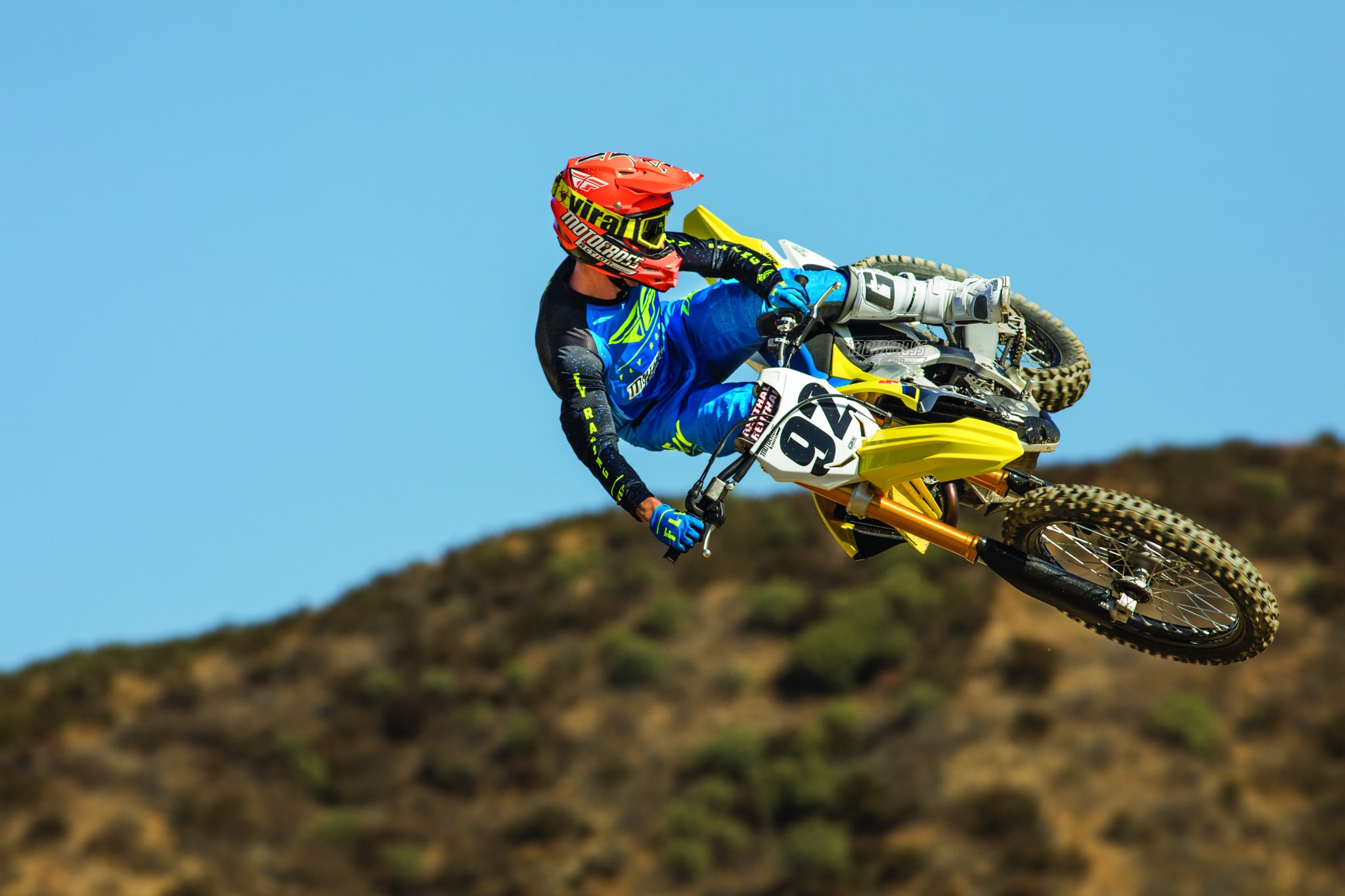MXA TECH SPEC: 10 WAYS TO IMPROVE YOUR 2020-2021 SUZUKI RM-Z450
(1) VP T4 fuel. T4 is a cleaner-burning replacement for pump gas. Test riders felt that the VP T4 improved throttle response. This was most noticeable in corners, specifically in the middle of deep ruts. The cleaner-burning fuel eliminated the hesitation problem that we had with pump gas. This helped test riders get the bike on the pipe quicker, especially in deep loam or ruts.
(2) High-pressure radiator cap. The stock 1.1 kg/cm2 RM-Z450 radiator cap allowed our RM-Z450’s coolant levels to constantly drop to just above the radiator fins during a long moto. Twin Air and CV4 offer 1.8 kg/cm2 and 2.0 kg/cm2 radiator caps (even the 1.6 cap from a KX65 is better than the stock RM-Z cap). By increasing the pressure in the radiators, the boiling point is raised to keep the coolant in the radiators.
(3) Heavy-duty clutch springs. Hinson and Pro Circuit make stiffer clutch spring kits for the RM-Z450. The heavier springs improve clutch feel, increase bite on acceleration and outlast the stock clutch plates. We don’t always run heavy-duty clutch springs; sometimes we find that three stiff springs can fine-tune the feel at the lever.
(4) Works Connection Elite clutch perch. With the stiffer clutch springs installed, the clutch pull was harder than stock. To cure this, we swapped the stock Suzuki clutch perch for a Works Connection Elite clutch perch assembly. Its three sealed-bearing pivots and better leverage ratio increased the window of clutch engagement. Additionally, the stock RM-Z450 free-play adjuster was hard to use on the fly. Works Connection’s thumb-wheel adjuster could be moved with the flip of our thumbs, even in midair.
(5) FCP engine mounts. The turning characteristics of the RM-Z450 are second to none. Straight-line stability, on the other hand, is less confidence-inspiring. At speed across rough ground, the 2020 RM-Z450 can be scary. Even if you hit the same line lap after lap, the overly rigid chassis will do something different every time. We ran FCP head stays and motor mounts to allow more flex and create a more forgiving ride.
(6) ODI RC4 handlebars. The stock Renthal 821 Fatbars fed back a lot of vibration. We switched to ODI RC4 signature handlebars. They feature ODI’s Controlled Flex Technology, which uses an elastomer cushion in the crossbar to allow the bars to flex at a controlled rate. When paired with ODI’s Emig V2 lock-on grips, comfort increased significantly.
(7) HGS exhaust system. HGS exhausts are not well known in the USA, but they are imported by Bud Racing USA. MXA’s experience with HGS pipes is very limited, but we elected to outfit our RM-Z with one of their systems. The HGS’ stainless steel system is 1.07 pounds lighter than the stock exhaust and features a carbon fiber end cap. On the track, the HGS system kept the same smooth power delivery as the stock system, but offered extra throttle response throughout the power curve that was highlighted by strong midrange and didn’t take away any top-end.
(8) Gearing. With the added pep of the VP T4 fuel and the HGS exhaust, we doubled down by going from the standard 13/50 gearing to a 13/51 ratio with Supersprox sprockets. This allowed us to use third gear sooner because we had more drive out of tight turns with the lower gearing.
(9) TM Designworks chain guide. The stock RM-Z450 chain guide wears out incredibly fast and will not only eat through the rubber buffer but the metal cage as well. We trust the TM Designworks Factory Edition #1 chain guide. Its solid body is made with Return Memory plastic that returns to its original position after being dragged through ruts. It lasts almost indefinitely.
(10) Hybrid shock. The MXA wrecking crew is not a fan of the stock Showa BFRC shock. It is unique to motocross shocks in that it does not like bumps. We tested re-valved BFRC shocks that were better than stock but not better than what other bikes had to offer. Luckily, MXA test rider Brian Medeiros works for TBT Racing, and he believed that he could build a better shock than the BFRC out of the parts bin. Brian’s hybrid shock features a 2015 KTM 450SXF WP shock body combined with a 2017 Showa A-Kit 18mm shock shaft and clevis. Brian shortened the shock by 2mm to lower the rear end and re-valved the shock to iron out the RM-Z450’s signature stinkbug chassis. Brian’s hybrid shock was better balanced, squatted on corner entry, improved rear-wheel traction and didn’t step out when leaned into a bumpy corner. Of course, you can’t get MXA’s one-off hybrid shock, but we feel that WP’s aftermarket RM-Z450 Trax shock is the best option for a serious racer.







Comments are closed.